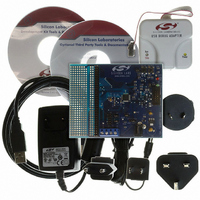C8051F226DK Silicon Laboratories Inc, C8051F226DK Datasheet - Page 136

C8051F226DK
Manufacturer Part Number
C8051F226DK
Description
DEV KIT F220/221/226/230/231/236
Manufacturer
Silicon Laboratories Inc
Type
MCUr
Datasheet
1.C8051F226DK.pdf
(146 pages)
Specifications of C8051F226DK
Contents
Evaluation Board, Power Supply, USB Cables, Adapter and Documentation
Processor To Be Evaluated
C8051F22x and C8051F23x
Interface Type
USB
Silicon Manufacturer
Silicon Labs
Core Architecture
8051
Silicon Core Number
C8051F226
Silicon Family Name
C8051F2xx
Lead Free Status / RoHS Status
Contains lead / RoHS non-compliant
For Use With/related Products
C8051F220, 221, 226, 230, 231, 236
Lead Free Status / Rohs Status
Lead free / RoHS Compliant
Other names
336-1241
- Current page: 136 of 146
- Download datasheet (2Mb)
C8051F2xx
17.2.3. Mode 2: Baud Rate Generator
Timer 2 can be used as a baud rate generator for the serial port (UART) when the UART is operated in
modes 1 or 3 (refer to Section 16.1 for more information on UART operational modes). In Baud Rate Gen-
erator mode, Timer 2 works similarly to the auto-reload mode. On overflow, the 16-bit value held in the two
capture registers (RCAP2H, RCAP2L) is automatically loaded into the counter/timer register. However, the
TF2 overflow flag is not set and no interrupt is generated. Instead, the overflow event is used as the input
to the UART's shift clock. Timer 2 overflows can be used to generate baud rates for transmit and/or
receive independently.
The Baud Rate Generator mode is selected by setting RCLK (T2CON.5) and/or TCLK (T2CON.4) to logic
one. When RCLK or TCLK is set to logic 1, Timer 2 operates in the auto-reload mode regardless of the
state of the CP/RL2 bit. The baud rate for the UART, when operating in mode 1 or 3, is determined by the
Timer 2 overflow rate:
Note, in all other modes, the time base for the timer is the system clock divided by one or twelve as
selected by the T2M bit in CKCON. However, in Baud Rate Generator mode, the time base is the system
clock divided by two. No other divisor selection is possible. If a different time base is required, setting the
C/T2 bit to logic 1 will allow the time base to be derived from the external input pin T2. In this case, the
baud rate for the UART is calculated as:
Where FCLK is the frequency of the signal supplied to T2 and [RCAP2H:RCAP2L] is the 16-bit value held
in the capture registers.
As explained above, in Baud Rate Generator mode, Timer 2 does not set the TF2 overflow flag and there-
fore cannot generate an interrupt. However, if EXEN2 is set to logic 1, a high-to-low transition on the T2EX
input pin will set the EXF2 flag and a Timer 2 interrupt will occur if enabled. Therefore, the T2EX input may
be used as an additional external interrupt source.
136
Overflow
SYSCLK
Timer 1
T2EX
T2
PORT0
PORT0
MUX
MUX
2
2
EXEN2
TR2
Baud Rate = FCLK / [32 x (65536 – [RCAP2H:RCAP2L]) ]
0
1
0
1
Figure 17.6. T2 Mode 2 Block Diagram
S
M
O
D
Baud Rate = Timer 2 Overflow Rate / 16.
C/T2
PCON
G
F
1
G
F
0
O
S
T
P
D
E
L
I
TCLK
CP/RL2
RCAP2L
EXEN2
Rev. 1.6
RCLK
TCLK
EXF2
C/T2
TR2
TF2
TL2
RCAP2H
TH2
Interrupt
Reload
Timer 2
Overflow
1
0
1
0
TCLK
RCLK
16
16
RX Clock
TX Clock
Related parts for C8051F226DK
Image
Part Number
Description
Manufacturer
Datasheet
Request
R
Part Number:
Description:
SMD/C°/SINGLE-ENDED OUTPUT SILICON OSCILLATOR
Manufacturer:
Silicon Laboratories Inc
Part Number:
Description:
Manufacturer:
Silicon Laboratories Inc
Datasheet:
Part Number:
Description:
N/A N/A/SI4010 AES KEYFOB DEMO WITH LCD RX
Manufacturer:
Silicon Laboratories Inc
Datasheet:
Part Number:
Description:
N/A N/A/SI4010 SIMPLIFIED KEY FOB DEMO WITH LED RX
Manufacturer:
Silicon Laboratories Inc
Datasheet:
Part Number:
Description:
N/A/-40 TO 85 OC/EZLINK MODULE; F930/4432 HIGH BAND (REV E/B1)
Manufacturer:
Silicon Laboratories Inc
Part Number:
Description:
EZLink Module; F930/4432 Low Band (rev e/B1)
Manufacturer:
Silicon Laboratories Inc
Part Number:
Description:
I°/4460 10 DBM RADIO TEST CARD 434 MHZ
Manufacturer:
Silicon Laboratories Inc
Part Number:
Description:
I°/4461 14 DBM RADIO TEST CARD 868 MHZ
Manufacturer:
Silicon Laboratories Inc
Part Number:
Description:
I°/4463 20 DBM RFSWITCH RADIO TEST CARD 460 MHZ
Manufacturer:
Silicon Laboratories Inc
Part Number:
Description:
I°/4463 20 DBM RADIO TEST CARD 868 MHZ
Manufacturer:
Silicon Laboratories Inc
Part Number:
Description:
I°/4463 27 DBM RADIO TEST CARD 868 MHZ
Manufacturer:
Silicon Laboratories Inc
Part Number:
Description:
I°/4463 SKYWORKS 30 DBM RADIO TEST CARD 915 MHZ
Manufacturer:
Silicon Laboratories Inc
Part Number:
Description:
N/A N/A/-40 TO 85 OC/4463 RFMD 30 DBM RADIO TEST CARD 915 MHZ
Manufacturer:
Silicon Laboratories Inc
Part Number:
Description:
I°/4463 20 DBM RADIO TEST CARD 169 MHZ
Manufacturer:
Silicon Laboratories Inc










